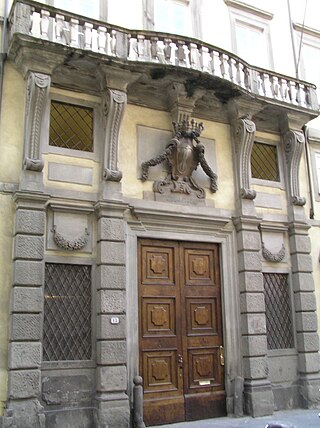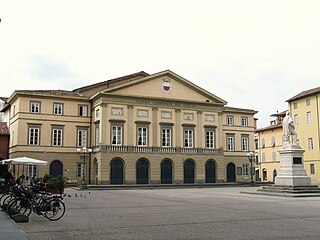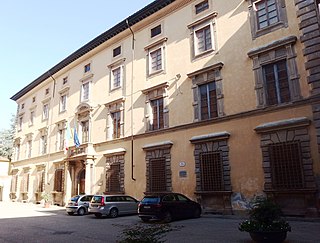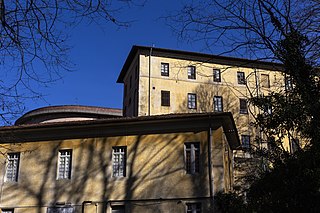
Villa Mansi is a country palace and gardens located in Segromigno in Monte, near Capannori, about 12 kilometers northeast of the city of Lucca in the region of Tuscany, Italy.

Villa Mansi is a country palace and gardens located in Segromigno in Monte, near Capannori, about 12 kilometers northeast of the city of Lucca in the region of Tuscany, Italy.
The villa was initially constructed in the 16th century by the Benedetti family, who sold the villa to the Cenami family, [1] who included the Abbot Paolo Cenami, in 1599. The architect Muzio Oddi rebuilt the villa and gardens starting in 1634. The unusual facade has two wings flanking a central portico with thin double columns, accessed by a double ramped stairwell. In 1675 the property was acquired by Ottavio Mansi, from a wealthy silk merchant family, and during the 18th century, still owned by this family, the villa underwent major refurbishment under the guidance of the architect Giusti, provided with Rococo touches such as statuary and a roofline balustrade. However, the gardens and fountains/water works were theatrical masterworks designed by Filippo Juvarra. The interiors were painted by Stefano Tofanelli, [2] including mythologic themes such as the Trial of Midas, the Death of Marysias, and a large ceiling fresco depicting the Triumph of Apollo. [3]
The villa and the gardens have been modified in the following centuries. The gardens acquired a more natural and less formal layout. The gardens still retain scenic setpieces with grottoes. [4]
The villa and gardens are open to tours. It lies close to Villa Mazzarosa and Villa Torrigiani. [5]

Lucca is a city and comune in Tuscany, Central Italy, on the Serchio River, in a fertile plain near the Ligurian Sea. The city has a population of about 89,000, while its province has a population of 383,957.

Giovanni di Nicolao Arnolfini was an Italian merchant from Lucca, a city in Tuscany, Italy. He spent most of his life in Flanders, then part of the Duchy of Burgundy, probably always based in Bruges, a wealthy trading city and one of the main towns of the Burgundian court. The Arnolfini were a powerful family in Lucca, involved in the politics and trade of the small but wealthy city, which specialised in weaving expensive cloth.

The province of Lucca is a province in the Tuscany region of Italy. Its capital is the city of Lucca.

The Basilica of San Frediano is a Romanesque church in Lucca, Italy, situated on the Piazza San Frediano.

Capannori is an Italian town and comune in the province of Lucca, in northern Tuscany.

The Villa Marlia or Villa Reale di Marlia is a late-Renaissance palazzo or villa, and its estate's property that includes renowned gardens and adjacent villas and follies within the compound. It is located in Capannori, in the Province of Lucca, west of Florence, in the northern Tuscany region of Italy.

The Villa Torrigiani is located in the hamlet of Camigliano, a town in Capannori (Lucca). It is a historical villa, dating from the second half of the sixteenth century.

The Ducal Palace is a palace in Lucca, Tuscany, central Italy.

Palazzo Tucci is an 18th-century palace in central Lucca, Region of Tuscany, Italy.

The Museo Nazionale di Palazzo Mansi is one of the two main art museum hosting tapestry collections and mainly post-19th century art collections owned by the city of Lucca, Italy. The collection is displayed in the Baroque palace, formerly belonging to the Mansi family, and located in central Lucca. Many of the original room decorations remain in place.

The Teatro del Giglio is the historic city theater and opera house located in Piazza del Giglio #13 and #15 in the center of Lucca, region of Tuscany, Italy.

Piazza dell'Anfiteatro is a public square in the northeast quadrant of the walled center of Lucca, region of Tuscany, Italy. The ring of buildings surrounding the square follows the elliptical shape of the former second century Roman amphitheater of Lucca. The square can be reached through four gateways located at the four vertices of the ellipse. A cross is carved into the central tile of the square with the arms pointing to the four gateways of the square.

The Palazzo Cenami is a Renaissance-style palace located on Via Santa Croce in central Lucca, region of Tuscany, Italy. The palace was designed in 1530 by Nicolao Civitali. Some attribute the palace's Florentine style of architecture to Agostino Marti in 1501.

The Palazzo Guidiccioni is a 16th-century urban palace located in Lucca, region of Tuscany, Italy. The Guidiccioni had owned the site in the 8th century. Construction if the building we see today is attributed to Vincenzo Civitali. The palace was acquired by the government in 1822.

Santissima Trinità is a Renaissance-style, Roman Catholic church in via Elisa in central Lucca, region of Tuscany, Italy.

San Cristoforo di Lammari is 12th-century, Romanesque-style, Roman Catholic parish church in Capannori, province of Lucca, region of Tuscany, Italy.

San Gennaro is 12th-century, Romanesque-style, Roman Catholic church in the neighborhood of San Gennaro in the town limits of Capannori, province of Lucca, region of Tuscany, Italy.

The Hospital of Fregionaia is a set of buildings in a former monastery, made into hospital for indigent, then a psychiatric hospital, and which in 2019 lies unused and abandoned, and which is located on Via di Fregionaia in the hills outside Santa Maria a Colle - Maggiano, province of Lucca, region of Tuscany, Italy. It is representative of the large psychiatric hospitals established in the post-enlightenment period of the 18th-19th century.
Villa Mazzarosa is an early 17th-century country palace and gardens located in Segromigno in Monte, near Capannori, about 12 kilometers northeast of the city of Lucca in the region of Tuscany, Italy.

Sant'Andrea di Compito is a frazione of Capannori in the province of Lucca region of Tuscany in Italy. The settlement styles itself The Village of Camellias as it is home to an exceptional collection of ancient Camellia Cultivars which attract visitors annually.
43°53′35″N10°35′27″E / 43.8931°N 10.5908°E